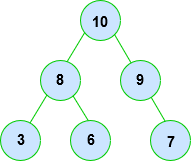Complete Guide To Heaps
Heaps
A heap is a complete binary tree in which every node key is compared with its children and arranged accordingly. It is also called as a binary heap.
It has two properties :
- All levels are full, except the last one, which is filled from left to right
- Every node should have element greater (or smaller) than or equal to all its children nodes. (duplicates are allowed)
The ordering is of two types:
- Max heap : A max heap is a complete binary tree in which the key value in each node is greater than or equal to the key values in the child node.
-
Min heap : A min heap is a complete binary tree in which the key value in each node is smaller than or equal to the key values in its child node.

As heap is a complete binary tree, height of the tree will be logN
Array Representation of Heaps
Heaps can be easily represented as an array since it is a complete binary tree.
Array-based representation is space-efficient.


Operations on Heap
Heapify
The process of creating a heap data structure froma binary tree is known as Heapify.
Min-Heap or a Max-Heap are constructed using this process.
- create binary tree from array
- Start from the first index of non-leaf node with index n/2-1.
- set largest = i
- index of :
[left child] =2i + 1
[right child] =2i + 2.
If left child is greater than current node (i.e. element at ith index), set index of left child as largest.
If right child is greater than current node , set index of right child as largest - Swap largest with current element.
- Repeat steps 2-6 until the subtrees are also heapified.

void Heapify(vector<int> &heap, int i)
{
int size = heap.size();
int largest = i;
int l = 2 * i + 1; //left child
int r = 2 * i + 2; //right child
if (l < size && heap[l] > heap[largest])
largest = l;
if (r < size && heap[r] > heap[largest])
largest = r;
if (largest != i)
{
swap(&heap[i], &heap[largest]); // perform swapping
Heapify(heap, largest);
}
}
Insertion in Heap
Inserting in a Max heap
- Create a new node. (If no node present)
- If a node is already present, just insert the new node at the end (last node from left to right.)
- Heapify
Note :For
Min Heap, parent node is always smaller than newNode.

void insert(vector<int> &heap, int val)
{
int size = heap.size();
if (size == 0)
{
heap.push_back(val);
}
else
{
heap.push_back(val);
for (int i = size/2-1; i >= 0; i--)
{
heapify(heap, i);
}
}
}
Deletion in Heap
To delete a node in Max heap:
- Select value to be removed.
- Swap it with the last element.
- Remove the last element.
- Heapify the tree.
Note : For
Min Heap, both child nodes are greater than the current node.

void hDelete(vector<int> &heap, int val)
{
int size = heap.size();
int i;
for (i = 0; i < size; i++)
{
if (val == heap[i])
break;
}
swap(&heap[i], &heap[size - 1]);
heap.pop_back();
for (int i = size/2-1; i >= 0; i--)
{
heapify(heap, i);
}
}
